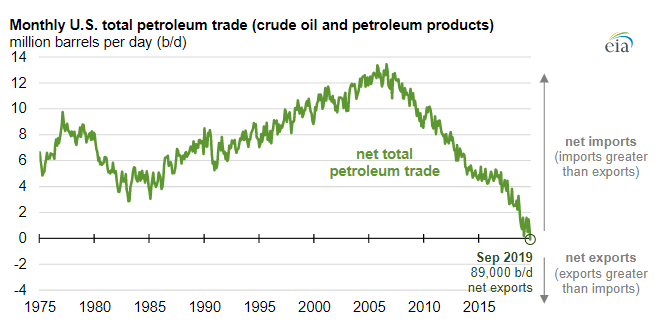U.S. Petroleum Exports Surpass Imports, Setting New Monthly Record in Over Four Decades: EIA

U.S. exports of crude oil and petroleum products exceeded imports by 89,000 barrels a day in September, a turning point from only a decade ago, when imports surpassed exports by 10 million barrels a day, according to a Dec. 31 report from the U.S. Energy Information Administration. The agency attributed the trend to changes in U.S. trade patterns for crude oil and petroleum, resulting in a steady decrease in net imports. Last September marked the first month that exports outpaced imports since 1973.
- Growing U.S. crude oil production, which rose from an average of 5.3 million b/d in 2009 to 12.1 million b/d through September, contributed to a decrease in imports from an average of 9 million b/d to 7.0 million b/d over the same period.
- U.S. crude oil exports have been the largest contributor to petroleum export growth after the U.S. lifted restrictions on exporting domestically produced crude oil in December 2015; since then, crude oil exports grew from 591,000 b/d in 2016 to 2.8 million b/d in 2019 through September.
- Despite the growth in exports, the U.S. remains a net importer of crude oil, primarily heavy high-sulfur crude oils that most U.S. refineries are configured to process, with more than 60 percent of the supply coming from Canada and Mexico.
- Nevertheless, U.S. refineries responded to growing domestic and international demand for petroleum products by increasing throughput, with gross inputs into refineries rising to an annual average 17.0 million b/d through the third quarter of 2019 from 14.6 million b/d in 2009, and have regularly set new monthly records.
- Refinery production of petroleum products outpaced consumption, contributing to higher petroleum product exports, resulting in net petroleum product exports of 3.2 million b/d in 2019 compared to net imports of 698,000 b/d in 2009.
- Although the U.S. currently imports more crude oil than it exports, petroleum product exports are higher than imports, resulting in net total petroleum exports; the EIA expects continued growth in U.S. net petroleum exports, averaging 751,000 b/d in 2020, making the country a net petroleum exporter for the first time on an annual basis.
EnerKnol Pulses like this one are powered by the EnerKnol Platform—the first comprehensive database for real-time energy policy tracking. Sign up for a free trial below for access to key regulatory data and deep industry insights across the energy spectrum.
ACCESS FREE TRIAL